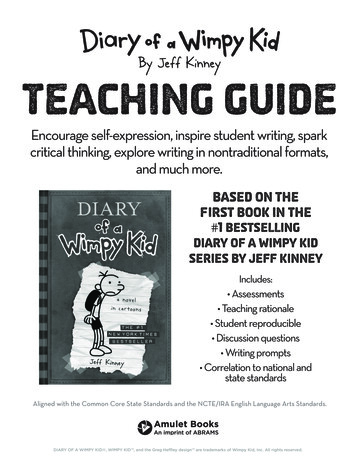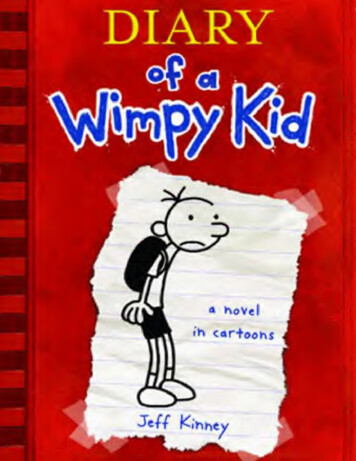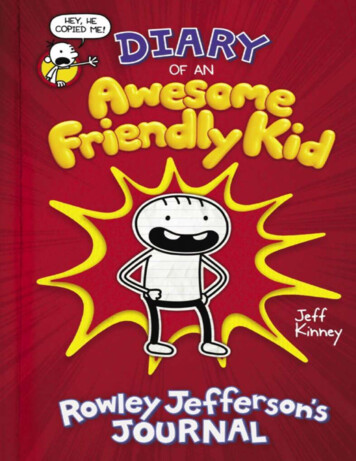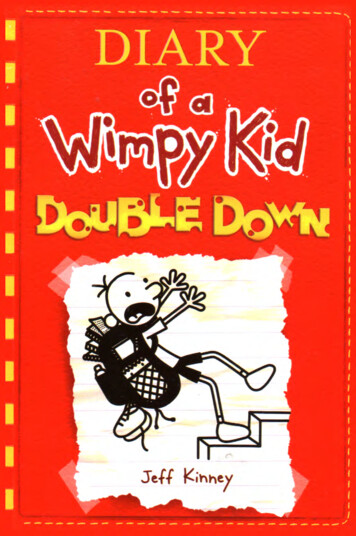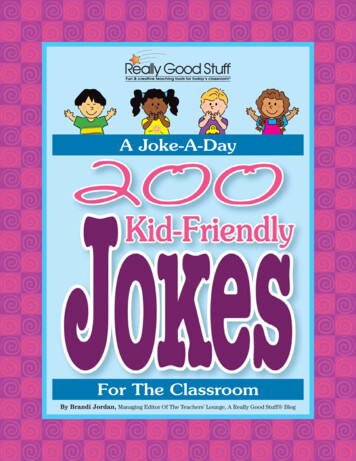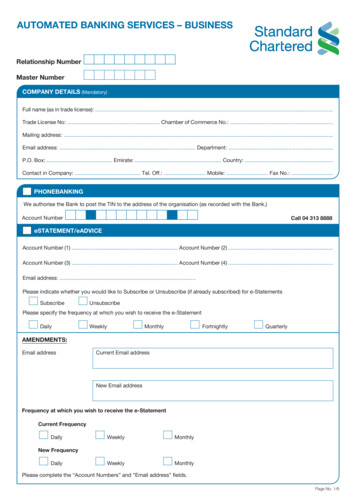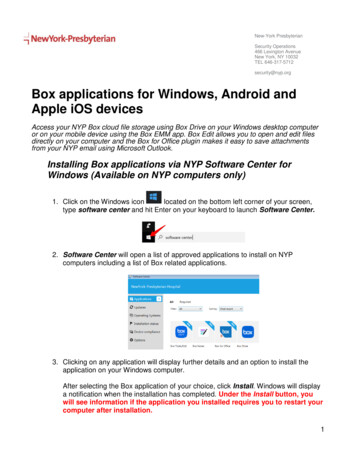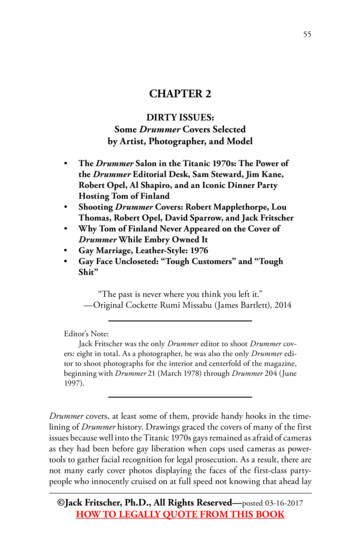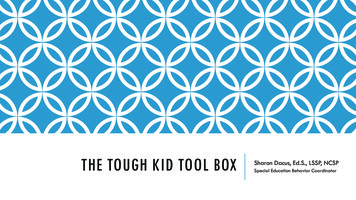
Transcription
THE TOUGH KID TOOL BOXSharon Dacus, Ed.S., LSSP, NCSPSpecial Education Behavior Coordinator
THE TOUGH KID TOOL BOXpracticalClassroom-testedReady to use guide to managing andmotivating tough-to-teach studentsWilliam R. Jenson, Ph.D., Ginger Rhode, Ph.D., H. Kenton Reavis, Ed.D.
WHAT DOES A TOUGH KID LOOK LIKE?
THECOERCIVEPAINCONTROLCYCLE
2 PROACTIVE INTERVENTION STRATEGIES1. Classroom rulesStructuredclassroom2.
CLASSROOM RULES Keep the number of rules to a minimum Keep the wording of rules simple Have the rules logically represent your basicexpectations for behavior Keep the wording positive when possible Make your rules specific Make your rules describe behavior that is observable Publicly post the rules in a prominent place
CLASSROOM RULES (CONT.)5 Steps to TEACH classroom rules 1. Read the posted rule.2. Discuss why the rule is important.3. Role play the rule.4. Explain what will happen if the rule is followed5. Explain what will happen if the rule is not followed.
FIRSTDATES
Non Examples Be responsibleBe a good citizenPay attentionBe ready to learnDemonstrate respect for othersRespect others’ rightsTreat school property appropriatelyDo your bestTake care of your materialsMaintain appropriate behaviorin classroom Be kind to others Be politeExamples Turn in completed assignments on time Bring paper, pencil, and books to class Sit in your seat unless you have permission toleave it Do what your teacher asks right away Raise your hand and wait for permission to speak Unless you have permission to speak, talk onlyabout work Follow directions the first time given Keep hands, feet, and objects to yourself Bring books, notebooks, pens, and pencils to class Be in your seat when the bell rings Be in the classroom when the bell rings Walk, don’t run, when moving around theclassroom
STRUCTURED CLASSROOMSeating rules for tough kids:1. Move them close to you.2. Do not let tough kids sit together.Having tough kids close benefits YOU because:1. It invites less trouble.2. Proximity control is an effective antecedent strategy.3. You can reinforce the student more easily.
STRUCTURED CLASSROOM: SEATING CHART STRATEGYStep 1. On the first day of school (or a day selected to begin the strategy) send aletter home to all parents to inform them about your class and gather informationabout the student. Pair this with an incentive for the student to increase motivation to return the info!Step 2. Have all students complete a “student info page”Step 3. Gather the parent info, student info, and any other pertinent info (SpEd, 504,RtI, etc.) and set up a seating chart.Step 4. Create a typical seating chart that a substitute can use.Step 5. Create a larger seating chart in which you plug in pertinent info about thestudent.
Liz ThomasJacob BirchKristal StrandAsthma; doesn’t like to beredirected in front of peers; olderbrother deployed (Korea)Slow to warm up; doesn’t alwaysget breakfast; needs snacks, but nosugar“Perfectionist”; follows directions;mom teaches at elementaryLoves cats; So you think you candance; Jennifer LawrenceDallas Cowboys; Nike shoes; works3 hours a day after school at Pizzahut; blue; wants to own a businessSports (bball, softball, tennis); clubsoccer; went to Disney/HP thissummer; wants to go to BaylorVisual learnerUse as a peer tutorOHI for ADHD (sped); BIP(proximity, verbal reinforce, choices,advance notice, visual cues for backon task, limit repetition of masteredwork)Kip KingDrew HaleTerra ParkerParents divorcing currently; livingwith dad (works nights)Likes attention from peers andadults; struggle with readingNew to school and trying to makefriends (but going slowly)Writes stories and creates videogames; 4 siblings-split; abuse inhistory; trying to learn guitar; redRuns in 5Ks; football (JV); TennesseeTitans; dad ex-military; math is favsubject; went to Grand Canyon thissummerCheerleading; rides horses (rodeoson weekends); wants to be makeupartist or do equine therapy; “bling”SLD (Rdg fluency); Resource Rdg;place marker, extra time, limit rdgin front of peers, check forunderstandingTransfer; retained in 1st gradeTakes medication (mood)Parent Info; Student Info; Other (teacher info)
PRACTICAL REDUCTIVE TECHNIQUES State the student’s nameDo not use a question format when making a requestGet close to the student when making a requestUse a quiet voice, and do not yellLook students in the eyesGive the student timeDo not nagDo not give multiple requestsDescribe the behavior you wantBe unemotionalMake more start requests than stopVerbally reinforce compliance
PRECISIONREQUESTS:THEMAGICFORMULA
CONSEQUENCES: FOLLOWING THROUGH Consequences should be ONE component of building better behavior Ratio of praise to consequence should be at least 4:1 Consequences should be appropriate given the severity of the problem behavior Consequences are best when mild and brief Use restitution (building positive behaviors) as an alternative to punishment Do not punish when you are angry Avoid using a task/activity that you want to teach as a consequence If you are repeatedly giving consequences for the same behavior, stop and evaluateyour program
WHAT IF? CHARTPositive ConsequencesNegative ConsequencesSerious Behavior Clause: Out of class timeout Visit to principal SuspensionGood job!Lottery ticketSuperstar listClassroom helperPlanned free timeSeat scrambleEligible for home noteSpinner surpriseMystery motivatorVerbal warningName in consequences book5 minutes off recessMystery consequenceNot eligible for this week’s lotteryLose computer reward timeEat lunch away from peersCall homeStay after classInter-class timeout (buddy room)
POSITIVE REINFORCEMENT STRATEGIESThe Tough Kid Book will teach you: The basics of positive reinforcement Arguments for and against positive reinforcement Types of positive reinforcement Effective use of positive reinforcement Selecting positive reinforcement Ideas for positive reinforcement systems Wandering social reinforcerChart movesMagic pensSpinnersMystery motivators Grab bagsLottery/Raffle TicketsYes/No programDots for motivationClassroom auctions
POSITIVE REINFORCEMENT: THE BASICSGiving something valued or desired to thestudent after he or she has done thedesired behavior that you are focusing onimproving.Replacement behavior occursReinforcement provided
POSITIVE REINFORCEMENT IN ACTIONhttp://www.youtube.com/watch?v JA96Fba-WHk
SELECTING POSITIVE REINFORCEMENTMethods of selecting: Reinforcer survey or interest inventory Spending time with the student Watch and listenHow to select reinforcement: Select age-appropriate reinforcementUse natural (and FREE!) reinforcement whenever it is effectiveThink of the student as a “customer”Use reinforcement appropriate to the student’s level of functioningAvoid partial praise statementsDo not confuse reinforcement with a student’s basic rights
USING POSITIVE REINFORCEMENT: IFEED!I : Reinforce IMMEDIATELY!F : Reinforce FREQUENTLY!E : Be ENTHUSIASTIC!E : Make EYE CONTACT!D : DESCRIBE what you like!Bonus Formula: A V XANTICIPATION VARIETY extra long-lasting success
AND LAST BUT NOT LEAST!Never, ever provide yourstudent with the reward beforehe or she gives you the goodbehavior!
VERBAL PRAISE: WHEN A STUDENT FOLLOWS THROUGH Dynamite follow-through! Wow--super follow-through! Cool when you do that! Hurray for you! You’re on target and a big help! You’re a winner! Magnificent following my directions! Spectacular! Super work! Bingo--wonderful job! Fantastic job! You’re on your way! You learned it correctly--good job! Well done! How smart of your to do it that way! What a good listener! I’m so proud of you! What fine work! That’s the best! You’re right on target!
REWARD SUGGESTIONS: WHEN A STUDENT FOLLOWS THROUGHPotential Social Motivators Hugs Congratulations Handshakes Winks High five! Touches or pats Praise Tickling Peer approval Thumbs up! Smiles Kisses Applause Recognition Nods Announcing success to othersPotential Activity Rewards Free time Pick a story Choose the activity Work a puzzle Show and tell Solve codes/puzzles Blocks Board games Teacher wears a funny hat Play instrument Pop balloons Draw or color Water paints Roll a wheeled toy Go on a walk Sing a song Comic book Turn in a swivel chair Arts and craft project String beads Look through binoculars Listen to a song Play with voice recorder Foot races Use a camera Extended time at a favoritecenter Dance Be swung around Jump rope Blow up balloon then let itgo! Be pushed on swing Walk the dog Computer time Make a sand castle Use the telephone Time to sleep Take shoes off during class Wear a hat to class Kaleidoscope Fake fingernails Flashlight Jacks Play money Fake tattoos Bubble-blowing set Marbles Jumping beans Sidewalk chalk Striped straws Jump rope Stamps Pencils with namePotential Material Motivators Balloons Molding clay Cards or games Crayons Magazines Color markers Model kits Books Miniature cars Compass Dinosaurs Fake spiders Comics Buttons Yo-yos Stickers Cowboy hat Coin bank Paints and brushes Whistle Trading cardsPotential Material Motivators Molding clay Popcorn Jelly beans Favorite candy or candy bar Chocolate milk Raisins Pretzels Goldfish Ice cream Soda Cereals Animal crackers Snack packs Chewing gum
EFFECTIVE R METHODS:MYSTERY MOTIVATOR Mystery motivators deliver random rewards for appropriate behavior. Select a motivating reward (but, shhh, It’s a mystery!) Write it or put a picture in a sealed envelope Define the behavior and criteria that will earn the motivator Track the student’s progress with them When they meet the goal, reveal the mystery!
EFFECTIVE R METHODS:CHART MOVES Chart moves uses a teacher-made dot-to-dot picture that is posted so the student can trackhis/her own progress. The chart determines when reinforcement will be delivered. Determine an appropriate behavior that will earn reinforcement. When you catch the student engaging in the appropriate behavior, he/she is allowed toconnect the next dot on the chart. Anytime the student reaches a special reward dot, a pre-specified larger reinforcer is given. You have the option of making the dot-to-dot path surround a picture of what it is that thestudent wants to earn. For example, the path could follow the outline of an ice cream cone torepresent ice cream as a larger reward that is earned when the entire path is completed.
EFFECTIVE R METHODS:YES/NO PROGRAM The Yes/No program is a ticket system that can be used to improve behavior. Select an appropriate behavior that you would like to increase (YES) and the inappropriatebehavior that you would like to decrease (NO). Select the reinforcers that can be earned by the student or students participating in this program. Explain to students the behaviors that will earn a YES or a NO. When you catch a student engaging in a YES behavior, write their name on the ticket, circle YES,and put it in a container. Be sure to verbally praise the student for the appropriate behavior andnote that he/she just earned a ticket. If the student exhibits a NO behavior, write the student’s name, circle NO, and deposit it in thecontainer. At the end of the period/day/week (you determine), hold a drawing. Select several tickets anddistribute rewards and privileges for students whose YES tickets are drawn.
EFFECTIVE R METHODS:MOTIVATION DOTS Motivation Dots is a great strategy for, you guessed it, students with low motivation! Thepremise of this strategy is that students who are unmotivated or “do nothing” are reinforcedby “doing nothing” and with probably work “to do nothing.” Gather small colored dots with adhesive on one side, such as those used to mark file folders. Tape an empty envelope to the student’s desk. Students will store the dots they earn in theirown envelope. Choose a replacement behavior that you can use the dots to reinforce. When you observe thestudent engaging in the replacement behavior, praise him/her, and place a dot in theenvelope. When the student comes to a problem on his/her work that they cannot do or don’t want todo, they can then use an earned dot, sticking it next to the problem to indicate a “free”problem that they do not have to do.
TheToughKidToughKidWHAT ELSE CANDO FOR YOU?Tool Box Practical assessment of tough kids Antecedent strategies Powerful reductive techniques in the classroom Advanced systems and strategies for tough kids Social skills training Mainstreaming tough kids Reproducibles, reproducibles, reproducibles!
Mrs. Jones, 10th Grade Language Arts2013-14Dear Parents:Please look over the syllabus of my 10th grade Language Arts class. I hope this outline willhelp you know what to expect so that you can assist your teenager in being successful inclass this year.I will be giving the students progress reports during the six weeks so that they know wherethey stand and can share the information with you. I have many students, so the best wayto know how your child is doing is to contact me. The number at high school is 720-7930ext. 5036 and my e-mail address is below.EXTRA CREDIT OPPORTUNITY: If you (the parent) send me an e-mail by Thursday, August29, that includes the information below, your child will be exempt from and receive a 105 forthe first vocabulary quiz on Friday, August 30. My e-mail address at school is:Jessica.Jones@ilovelanguage.com. If you would rather write the information down, youmay do so and send it back with your student.Information needed in e-mail: Parent name(s)Student’s nameAny special info I need to know about studentPlease sign and return the outline and parent letter acknowledgement page to me. Eachstudent should keep the outline (syllabus) in his or her binder. Also, the AHS StudentHandbook can be found on the high school webpage at pull down menu under AISD HelpDesk.I also encourage you to sign up for the Parent Portal where you can look at your child’sgrades. Go to the counselor’s tab on the high school webpage to sign up.Please see the page in this packet about Facebook.Thank you for your help. I am looking forward to a great year.Sincerely,Jessica M. Jones
Student InformationJones/English-10thName: Email (if you don’t mind sharing):Favorite color: Favorite song:Favorite food: Favorite restaurant:Favorite famous person: Favorite TV show:Favorite spare time activity: Favorite movie:Names and ages of brothers/sisters:Name(s) of guardian(s) you live with and how they are related to you:Something fun you did this summer:What are three goals you have for the 2013 - 2014 school year?Extra-curricular activities you plan to be involved in at school this year:Extra-curricular activities you plan to be involved in outside of school this year:Do you have a job?YESNOIf so, how many hours per week do you work?What do you like MOST about school?What do you like LEAST about school?How do you think people should treat each other?Add anything else I should know about you so that I can assist you better:
Student InformationJones/English-10th
reproducible 1-1Fora desK-6GrTough Kid Tool ents:See pp. 3-6 for suggestions for use. 2009 Jenson, Rhode & Reavis
reproducible 1-4Fora desK-6GrTough Kid Tool BoxWork Like a Dog for aMYSTERY MOTIVATORMONTUEWEDTHURFRIBONUSName:Comments:See pp. 3–6 for suggestions for use. 2009 Jenson, Rhode & Reavis
reproducible 1-7Fora desK-6GrTough Kid Tool BoxDrive Away With aMYSTERY MOTIVATORMONTUEWEDTHURFRIBONUSName:Comments:See pp. 3–6 for suggestions for use. 2009 Jenson, Rhode & Reavis
reproducible 1-8Fora desK-6GrTough Kid Tool BoxBe Cool for aMYSTERY MOTIVATORMONTUEWEDTHURFRIBONUSName:Comments:See pp. 3–6 for suggestions for use. 2009 Jenson, Rhode & Reavis
GrStartFinishChart Movesa desK-6reproducible 6-8b( Ve r s i o n 2 )See pp. 76–78 for suggestions for use.NameForTough Kid Tool Box 2009 Jenson, Rhode & Reavis
Fora desK-6GrTough Kid Tool Boxreproducible 6-8c( Ve r s i o n 3 )Chart MovesStartishFinNameSee pp. 76–78 for suggestions for use. 2009 Jenson, Rhode & Reavis
GrStartisFinhChart Movesa desK-6reproducible 6-8e( Ve r s i o n 5 )See pp. 76–78 for suggestions for use.NameForTough Kid Tool Box 2009 Jenson, Rhode & Reavis
r e p r o d u c i b l e 6 - 10Fora des4-6GrTough Kid Tool BoxYes/No eSee pp. 79–81 for suggestions for use. 2009 Jenson, Rhode & Reavis
r e p r o d u c i b l e 6 - 11Fora desK-3GrTough Kid Tool BoxSmiley/Frowny eNameNameNameNameNameSee pp. 79–81 for suggestions for use. 2009 Jenson, Rhode & Reavis
EFFECTIVE R METHODS: MYSTERY MOTIVATOR Mystery motivators deliver random rewards for appropriate behavior. Select a motivating reward (but, shhh, It’s a mystery!) Write it or put a picture in a sealed envelope Define the behavior and criteria that will e
